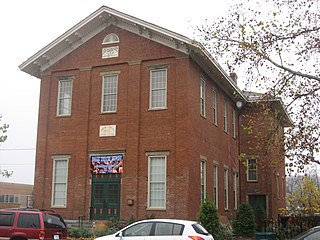Formation
Almost all territory within Ohio is at least nominally part of a township. Whenever a township falls entirely within a single municipality, or is coextensive with a single municipality, the township government is automatically abolished and consolidated with the municipal government under Ohio Rev. Code §703.22. This condition can be met in multiple ways:
- A municipality may annex territory until it becomes coextensive with the township. For example, the City of Cincinnati was originally located in Cincinnati Township in Hamilton County; the city annexed the township's remaining unincorporated territory in 1834.
- A township may be incorporated wholesale as a municipality. For example, in 1955, the residents of Van Buren Township in Montgomery County voted to incorporate as the Village of Kettering.
- A municipality may withdraw from its surrounding township, creating a township coextensive with the municipality that only exists on paper for the purpose of satisfying the requirement that the entire county lies within a township.
Under other provisions of state law, a township can exist nominally in rump form without a government if the remaining unincorporated portion of a township does not meet the requirements for incorporation or annexation.
In limited cases, territory may fall in no township when either:
- a township successfully petitions under Ohio Rev. Code §503.09 to create a new township exclusive of that part included in municipalities; or
- a township merges into a municipality under Ohio Rev. Code §709.43 through Ohio Rev. Code §709.48.
Withdrawal

In a legal procedure known as withdrawal, a municipality may request that the board of county commissioners modify the overlapping township's boundaries to exclude the municipality, and erect a new township coextensive with the municipality. The township effectively never exists because its government is immediately abolished. [1] [2] This legal fiction is common among the state's largest cities and popular among cities and villages in southwestern Ohio, where township government is seen as redundant to municipal government and a cause of higher taxation. [3]
A city or village that overlaps with multiple townships only needs to create a single paper township to withdraw from each township. Because Ohio law does not forbid townships from being located in multiple counties, [4] a municipality in multiple counties may petition multiple county boards of commissioners to create a single paper township shared among all the counties, or petition to create separate paper townships in each county. For example, both Butler [5] and Hamilton [6] counties share a nominal Heritage Township that corresponds with the City of Fairfield. Hamilton, Clermont, [7] and Warren counties each have a separate, nominal Loveland Township that corresponds to part of the City of Loveland. When the municipality annexes additional land, township boundaries must be explicitly adjusted to reflect the change; otherwise, the annexation remains in the original township as well as the municipality. [1] [8] [9] Under 1953 case law, a paper township may not be considered an adjoining township for the purpose of dissolving a township. [10]
A paper township does not have to share the municipality's name. For example:
- Louisville's Constitution Township is named after the city's nickname.
- Fairfield's Heritage Township is named after a failed 1995 proposal to incorporate two nearby townships in Hamilton and Warren counties as the City of Heritage. Being located primarily in Butler County, the township could not be named Fairfield because the county already had a Fairfield Township – the one from which Fairfield withdrew. [2]
- Canal Fulton's Milan Township is named after one of two villages that Canal Fulton annexed in the 1850s. [11] [12]
Unpopulated townships
A township can consist of unincorporated territory but lack a government because it has no resident population. On January 23, 1981, Wayne Township in Montgomery County was re-incorporated as the city of Huber Heights. However, a small portion of Wayne Township east of the Mad River was part of Wright-Patterson Air Force Base. Under Ohio Rev. Code §709.01, territory on military installations can not be incorporated without the approval of the Secretary of Defense. Thus, that portion of Wayne Township still nominally exists, but has no local government. It is currently the only unpopulated township in Ohio. [13] Decades earlier in 1943, Millcreek Township in Hamilton County became defunct, leaving no local government, after annexations by Cincinnati and withdrawals by other villages reduced the township to only a cemetery without even a resident property owner eligible to vote for annexation. [14]













